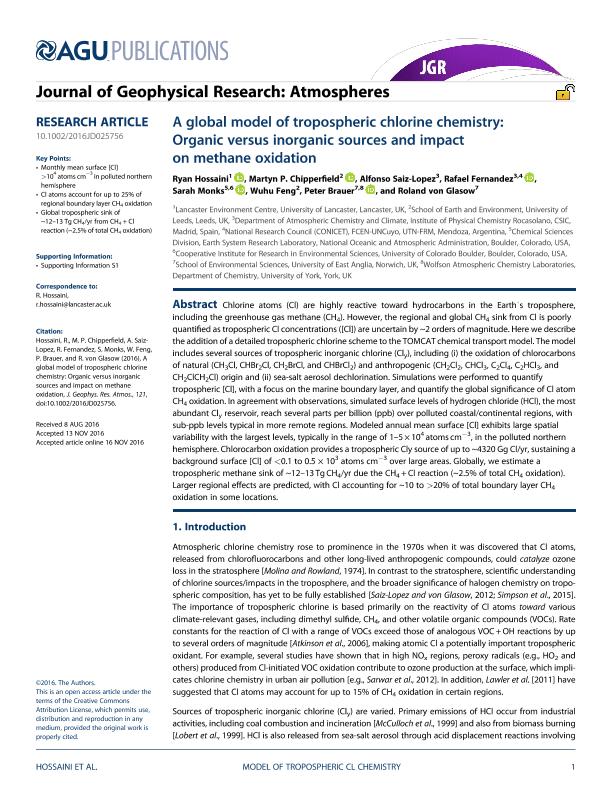Artículo
A global model of tropospheric chlorine chemistry: Organic versus inorganic sources and impact on methane oxidation
Hossaini, Ryan; Chipperfield, Martyn P.; Saiz Lopez, Alfonso; Fernandez, Rafael Pedro ; Monks, Sarah; Feng, Wuhu; Brauer, Peter; Von Glasow, Roland
; Monks, Sarah; Feng, Wuhu; Brauer, Peter; Von Glasow, Roland
 ; Monks, Sarah; Feng, Wuhu; Brauer, Peter; Von Glasow, Roland
; Monks, Sarah; Feng, Wuhu; Brauer, Peter; Von Glasow, Roland
Fecha de publicación:
12/2016
Editorial:
American Geophysical Union
Revista:
Journal of Geophysical Research
ISSN:
0148-0227
Idioma:
Inglés
Tipo de recurso:
Artículo publicado
Clasificación temática:
Resumen
Chlorine atoms (Cl) are highly reactive toward hydrocarbons in the Earth’s troposphere, including the greenhouse gas methane (CH4). However, the regional and global CH4 sink from Cl is poorly quantified as tropospheric Cl concentrations ([Cl]) are uncertain by ~2 orders of magnitude. Here we describe the addition of a detailed tropospheric chlorine scheme to the TOMCAT chemical transport model. The model includes several sources of tropospheric inorganic chlorine (Cly), including (i) the oxidation of chlorocarbons of natural (CH3Cl, CHBr2Cl, CH2BrCl, and CHBrCl2) and anthropogenic (CH2Cl2, CHCl3, C2Cl4, C2HCl3, and CH2ClCH2Cl) origin and (ii) sea-salt aerosol dechlorination. Simulations were performed to quantify tropospheric [Cl], with a focus on the marine boundary layer, and quantify the global significance of Cl atom CH4 oxidation. In agreement with observations, simulated surface levels of hydrogen chloride (HCl), the most abundant Cly reservoir, reach several parts per billion (ppb) over polluted coastal/continental regions, with sub-ppb levels typical in more remote regions. Modeled annual mean surface [Cl] exhibits large spatial variability with the largest levels, typically in the range of 1-5×104 atoms cm-3, in the polluted northern hemisphere. Chlorocarbon oxidation provides a tropospheric Cly source of up to ~4320 Gg Cl/yr, sustaining a background surface [Cl] of <0.1 to 0.5 × 103 atoms cm-3 over large areas. Globally, we estimate a tropospheric methane sink of ~12-13 Tg CH4/yr due the CH4 + Cl reaction (~2.5% of total CH4 oxidation). Larger regional effects are predicted, with Cl accounting for ~10 to >20% of total boundary layer CH4 oxidation in some locations.
Palabras clave:
TROPOSPHERIC CHLORINE
,
METHANE OXIDATION
,
VSL CHEMISTRY
Archivos asociados
Licencia
Identificadores
Colecciones
Articulos(CCT - MENDOZA)
Articulos de CTRO.CIENTIFICO TECNOL.CONICET - MENDOZA
Articulos de CTRO.CIENTIFICO TECNOL.CONICET - MENDOZA
Citación
Hossaini, Ryan; Chipperfield, Martyn P.; Saiz Lopez, Alfonso; Fernandez, Rafael Pedro; Monks, Sarah; et al.; A global model of tropospheric chlorine chemistry: Organic versus inorganic sources and impact on methane oxidation; American Geophysical Union; Journal of Geophysical Research; 121; 23; 12-2016; 14.271-14.297
Compartir
Altmétricas



